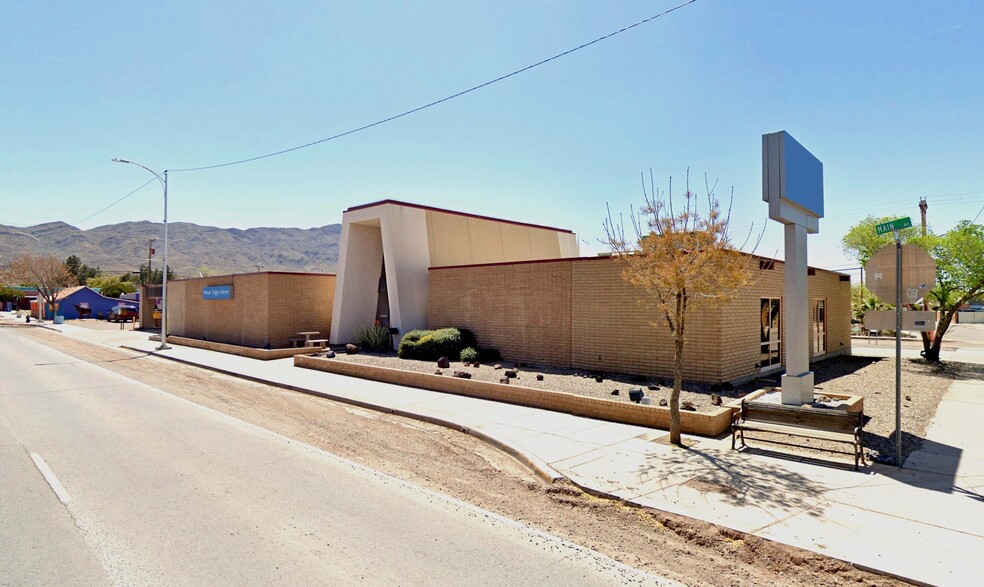You have to read the fine print and listen very closely at city meetings because Truth or Consequences staff and city commissioners explain very little.
As everyone knows by now, the city commission went ahead and bought the PNC Bank building to provide the police department with a new home. For more information, see: https://sierracountycitizen.org/new-police-building-rammed-down-publics-throat-again-third-time-is-the-charm/
The building was purchased for $430,000 with $200,000 coming out of the general fund and $230,000 coming out of the police department’s .25 percent gross receipts tax fund, approved by the city commission at the July 24 meeting.
City Manager Angela Gonzales said the city commissioners could “pay yourselves back” from the $2 million in loan proceeds, when they come in. The city commissioners didn’t respond or give Gonzales direction, so it is unknown if the purchase price will come out of the loan or if the $2 million will all be used for transforming the bank into a police building.
The city commission was presented with a draft ordinance for a $2 million loan a few months ago—a bond issue, all of it to be bought up and held by the New Mexico Finance Authority. The city commission approved it for “publication,” which consists of a legal ad in the Sentinel that the city commission would hold a public hearing in a month on the financing scheme.
Chris Muirhead of Modrall Sperling is the city’s longtime financial consultant on bonds and debt. When he presented the ordinance, he said the debt would be paid back from proceeds from the “state-shared” 1.225 percent gross receipts tax. This was the pledged revenue chosen, “because it’s the largest share of the city’s GRT,” Muirhead said. The bigger the pot of money, the more secure a bank feels, offering a lower interest rate to reflect the lower risk.
But when the ordinance went to public hearing July 24, Muirhead and the city commission took it off the agenda. Muirhead stated, vaguely, “It isn’t ready yet.”
I thought Muirhead meant he had not quite hammered out the terms, such as the interest rate, the life of the loan, the time period in which the $2 million needed to be spent, the reserve fund amount, the monthly or quarterly or yearly payment schedule. He had said the month before that the details would be ready by the time the city held a public hearing.
Nope, that wasn’t it, because there were no more details in the Aug. 14 city packet when it went to public hearing again. Muirhead drafted a whole new ordinance, which probably went to publication (someone told me it was in the July 25 Sentinel), but I didn’t catch it. None of the city commissioners nor Muirhead gave warning that the 1.225 GRT was not going to be the pledged revenue, the PD .25 GRT was. Therefore I was surprised during the Aug. 14 public hearing. The audio an mics are so bad at the city commission chambers that I barely heard Muirhead say “.25.” I followed him outside to confirm it.
Later I read the ordinance more closely. It too masks that the PD GRT is the pledged revenue. It refers to the local GRT that was “adopted June 11, 2011,” instead of stating it’s the police department’s or the “public safety” tax.
The city commission must have made the switch in a secret meeting, in violation of the Open Meetings Act, since it wasn’t done in a public meeting.
The city commission knows that the use of PD GRT has been a bone of contention for the community.
In 2017, when the city commission wanted to renovate the old armory into a police building, they wanted to use PD GRT to pay off the debt. The people pushed that financing scheme to referendum and voted it down.
The PD GRT was put in effect in 2011 under the leadership of Chief of Police Patrick Gallagher, who gave beautiful, fulsome, data-laden, well researched reports and cogent arguments for what he wanted to do and why. Gallagher said he couldn’t stop police turnover, he couldn’t get certified police officers, only uncertified police officers who left for better pay shortly after T or C paid to have them trained. He would use the PD GRT to increase salaries to attract and keep a better group of officers. Only then could the police force stop reacting to crime and become proactive, Gallagher said.
There is little evidence that the PD GRT has ever been used for salaries and retention. Audit reports and other financial documents show the city commission has regularly dipped into the fund for other purposes. To balance the general fund budget in fiscal year 2022-2023, nearly $1 million was transferred out of the PD GRT fund. So much for the city commissioners’ claims they support the police.
In 2023 the city commission again proposed renovating the old armory building as a police station. The financing ordinance stated that all local GRT, including the PD .25 GRT, as well as the state-shared 1.225 GRT, would be pledged to pay off a $4.5 million bond issue that would be sold on the open market. The bond/loan would also pay off the city’s debt with the New Mexico Finance Authority. Which debt and how much debt was unspecified.
The people pushed that financing scheme to referendum and voted it down last March.
Then the city commission bought the PNC building with cash in July, and now the financing scheme is becoming clear, after its already been purchased.
This financing scheme will also probably go to referendum. Ron Fenn, who spearheaded the 2018 and March referendums, spoke during the Aug. 14 public hearing. He said the petitions are ready to go with the approved ordinance language atop the pages to ensure signers aren’t being duped. No doubt the city commissioners will claim the people were duped by Fenn anyway, as they have consistently proclaimed for all referendums and initiative ordinances. As if they are clear and transparent communicators themselves.
Fenn has to get 209 signatures, which is 20 percent of the 1,044 people who voted in the last local election, the highest number voting in the last four local elections. He has until Sept. 15 to gather those signatures. The county clerk (the county runs the city’s elections) has 10 days to verify the signatures are registered T or C voters. Then the city commission must pass an election resolution at the closest meeting following verification of petition signers, which will probably be Nov. 12. An election is to be held within 60 days of the election resolution’s enactment, which would be around January 12, 2025, but there is a competing election law that says no special election can be held within 75 days of a regular election. So the special election, if it is held, might be mid-February 2025.
Not that the last referendum stopped the city commission from buying the PNC Bank building.
Why the city commission switched the debt payment from state-shared 1.225 GRT to PD .25 GRT is a mystery, especially considering how little revenue is left after they raid that fund.
It was a banner year for GRT revenue this fiscal year ending June 30, given the roundabouts, NMDOT construction, Vets Home construction and city waterline construction downtown. Yet the PD GRT only garnered about $382,000 from July 1, 2023 to June 30, 2024, as stated in the year-end quarterly report the city commission approved, along with this year’s upcoming budget at the July 24 meeting.
I asked City Manager Angela Gonzales why the PD GRT was so low. It was lower than the city’s hospital GRT revenue, which is .1875 percent—obviously a lower tax than the PD .25 percent. The city’s hospital GRT revenue was $532,448, according to the fourth-quarter financial report.
Gonzales said, “There were two intercepts from NMFA for loans. One loan was paid off in April so there will only be the one loan intercept in the PD GRT. The PD GRT only collects 62.95% of the GRT allocated to them and the remaining 37.05% goes into the general fund to help offset the police expenses.”
This switcheroo to a smaller pot of money will probably result in a higher interest rate on the NMFA bond/loan, a greater reserve account/set aside requirement and a greater dependence on the city’s general fund to pay for police operations—with no explanation by the city commission. The city commission passed the bond issue/loan unanimously, with no discussion—at least not in a public meeting.


Thank you again for your reporting, Kathleen.
We need to throw all these horrible “leaders” out on their bums.
Any T or C voter who wishes to sign the Referendum Petition can call or text me at 575-740=8571,